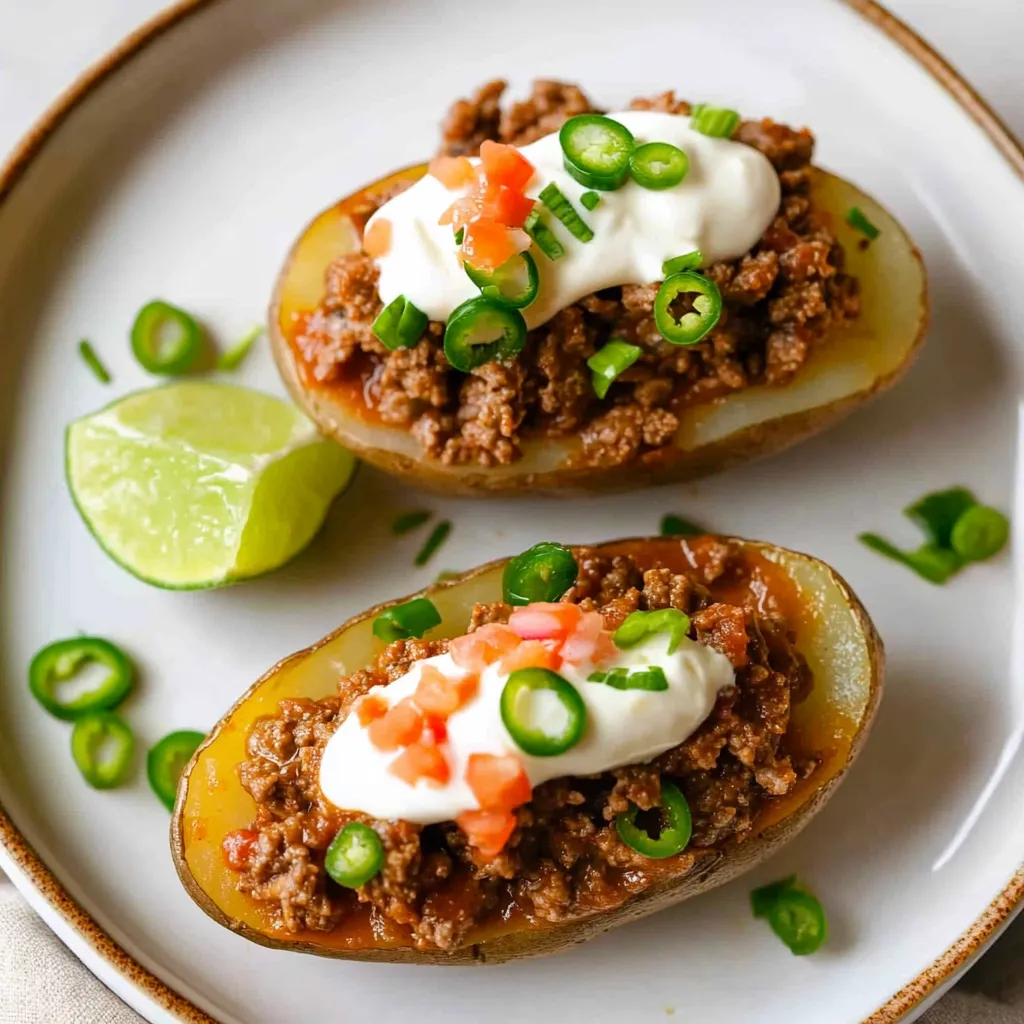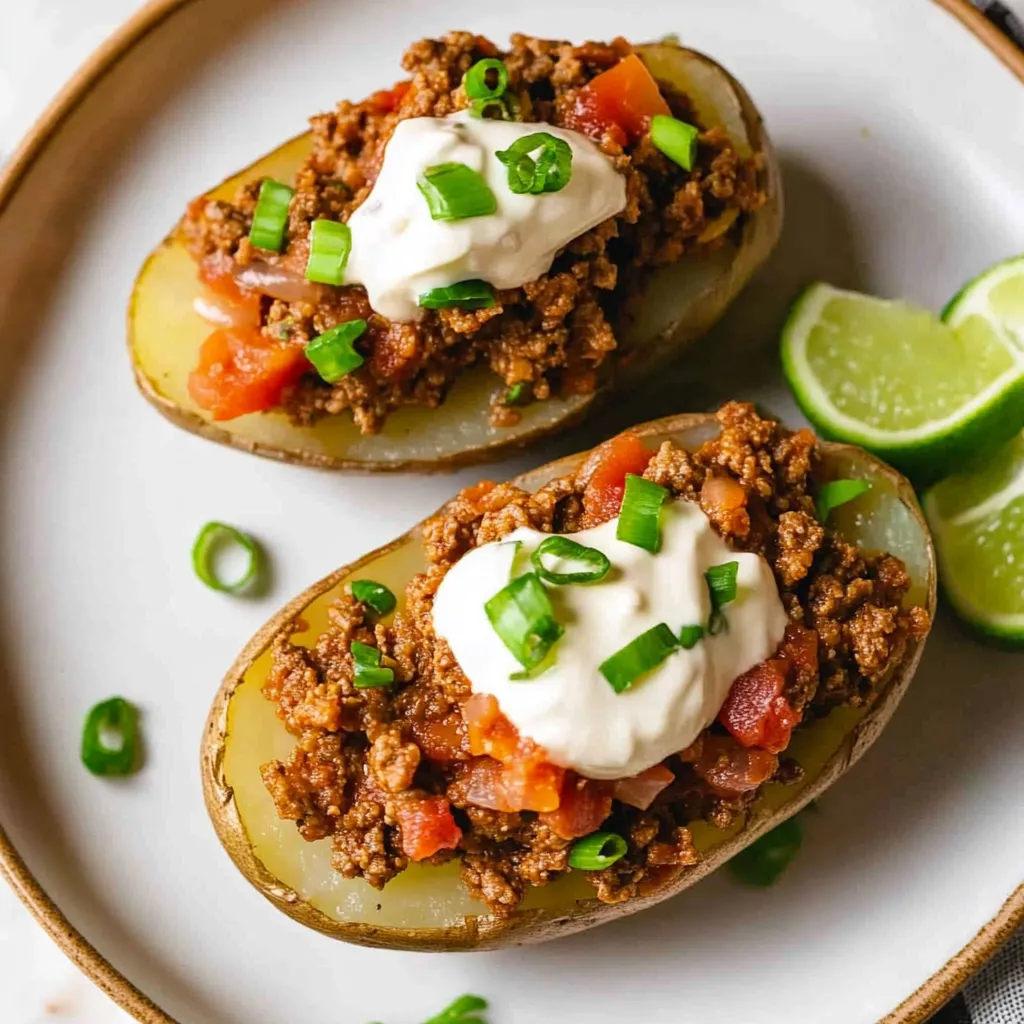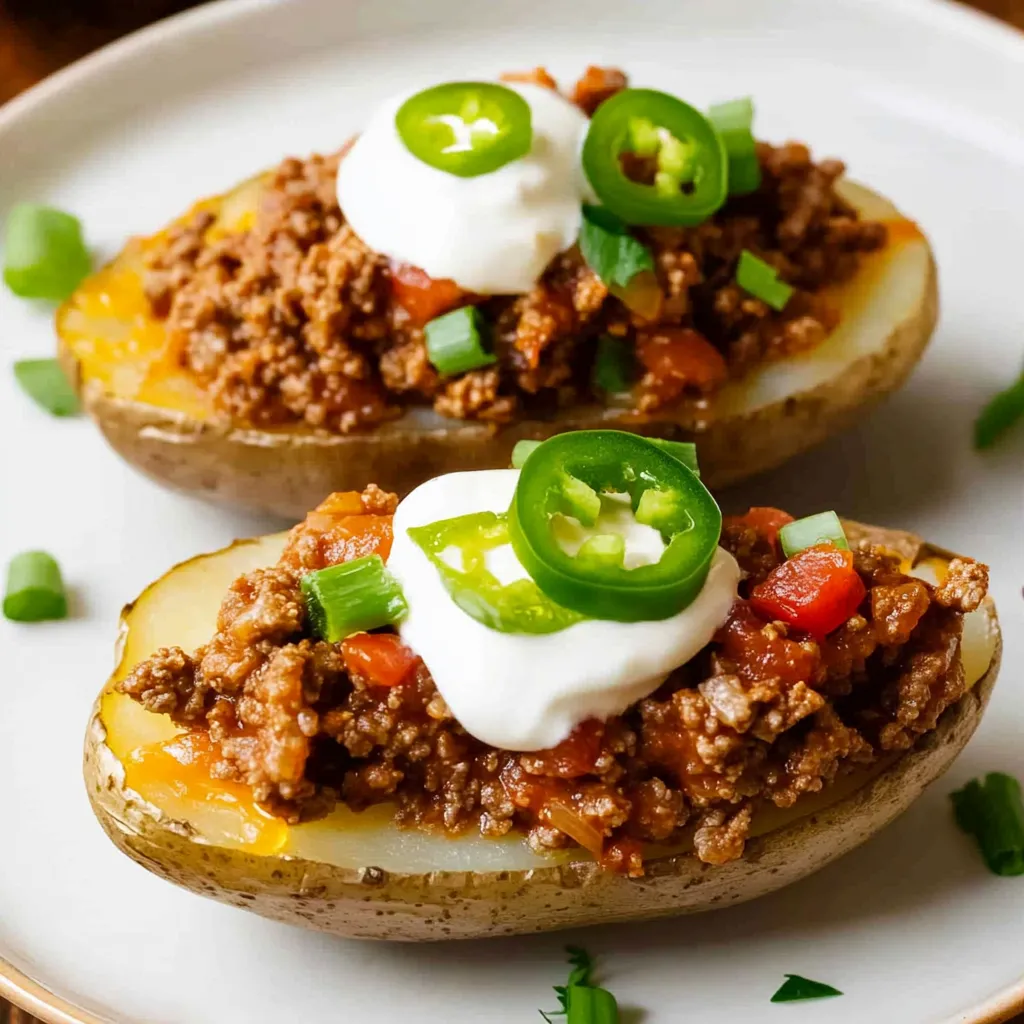 Pin it
Pin it
Combining two comfort foods into one meal sounds almost too simple to be exciting, but this recipe proves that straightforward ideas often deliver the best results. Baked potatoes become the foundation for seasoned taco meat, melted cheese, and whatever fresh toppings you want to pile on. The potato flesh soaks up the meat juices and gets creamy when you mash it with your fork, while the crispy skin adds texture that regular taco shells can't match. Each potato half becomes its own complete meal with protein, carbs, and enough substance to keep you satisfied for hours.
I started making these on busy weeknights when I needed something more substantial than regular tacos but didn't want to spend an hour cooking. My teenage son can eat three regular tacos and still raid the pantry an hour later, but two loaded potato halves keep him full until breakfast. The first time I served these, my husband looked skeptical about potatoes for taco night, but he went back for seconds and now requests them specifically.
Ingredients and Why They Matter
- Russet or Yukon Gold potatoes: (4 large, about 2-2½ pounds total) - Russets give you fluffy interiors and crispy skins while Yukon Golds offer a buttery flavor and creamier texture; pick potatoes that feel firm and heavy without any green spots, sprouts, or soft areas
- Olive oil: (3-4 tablespoons) - Coating potatoes in oil before baking creates that golden, crispy exterior and helps seasonings stick; avocado oil or canola oil work equally well if that's what you have
- Salt and black pepper: (1 teaspoon salt, ½ teaspoon pepper for potatoes) - Seasoning potatoes generously before baking means flavor penetrates the flesh instead of just sitting on top; kosher salt or sea salt work better than table salt here
- Lean ground beef: (1 pound, 90/10 or 93/7) - Leaner beef means less grease pooling in your finished dish while still providing plenty of meaty flavor and protein; ground turkey or chicken work as substitutes but cook slightly faster
- Taco seasoning: (1 packet or 3 tablespoons homemade) - Pre-mixed seasoning keeps things simple with the right balance of spices already measured; choose mild or spicy based on your family's preferences
- Salsa: (1 cup, any variety) - Salsa adds moisture and acidity that brightens the meat while providing extra flavor without additional chopping; pick a salsa you actually enjoy eating with chips because that flavor will come through
- Sharp cheddar cheese: (1½ cups shredded) - Sharp cheddar melts smoothly and has enough flavor to stand up to the seasoned meat; pepper jack adds heat, mozzarella gives you stretchy cheese pulls, or use whatever melting cheese you prefer
- Lime wedges: (1-2 limes cut into wedges) - Fresh lime juice brightened everything right before eating, cutting through richness and making all the flavors pop; bottled lime juice doesn't deliver the same fresh burst
How To Make It
- Prepare your oven and workspace:
- Move your oven rack to the middle position so hot air circulates evenly around the potatoes, then set the temperature to 400°F and let it preheat fully. Line a large rimmed baking sheet with parchment paper, making sure it covers the entire surface. The parchment prevents sticking and makes cleanup effortless. Get this ready before you start handling the potatoes so you're not scrambling with oily hands later. Having everything set up first makes the whole process flow smoothly.
- Season the potatoes:
- Scrub your potatoes under cold running water using a vegetable brush or rough sponge to remove any dirt clinging to the skins. Pat them completely dry with a kitchen towel because moisture prevents crisping. Cut each potato in half lengthwise, creating two equal pieces with flat sides. Place all the potato halves in a large mixing bowl and drizzle them with olive oil, then add salt and pepper. Use your hands to toss everything together, making sure every potato half gets coated with oil and seasoning on all sides. The oil should glisten on the surfaces but not pool in the bowl. Massage the seasonings into the cut sides especially well since that's where most of the flavor will penetrate.
- Arrange for baking:
- Transfer each potato half to your prepared baking sheet, placing them flat side down so the cut surface makes direct contact with the hot pan. This positioning is crucial because it creates caramelization and browning on that flat surface, developing deeper flavor. Space the potatoes at least an inch apart so heat reaches all sides evenly. If they're touching, they'll steam instead of roast, and you'll miss out on that crispy exterior. Don't crowd them onto a too-small pan - use two baking sheets if necessary to give each potato half enough personal space.
- Bake until golden:
- Slide the baking sheet into your preheated oven and set a timer for 40 minutes. Don't open the oven door to check on them before that because you'll release heat and extend cooking time. After 40 minutes, check the bottoms by carefully lifting one potato half with a spatula - you're looking for deep golden brown color. Test doneness by piercing the thickest part with a fork, which should slide in easily with no resistance. If the fork meets any firmness or the bottoms aren't golden yet, continue baking and check every 5 minutes. Total baking time usually runs 40-50 minutes depending on potato size. Properly cooked potatoes will feel tender all the way through and have crispy, browned bottoms.
- Brown the meat:
- While potatoes bake, heat a large skillet over medium-high heat until a drop of water sizzles on contact. Add your ground beef, breaking it up immediately with a wooden spoon or spatula. Sprinkle the taco seasoning over the meat as it cooks, stirring constantly to distribute the spices evenly. Use your spatula to crumble the meat into small, bite-sized pieces as it browns. Continue cooking, stirring frequently, until no pink remains and the meat has developed some brown bits on the edges, usually about 6-8 minutes. If you're using leaner beef, you won't have much fat to drain, but if grease pools in the pan, tip it carefully to one side and use paper towels to absorb the excess, or drain the meat in a colander.
- Simmer with salsa:
- Once the meat is fully browned, reduce your heat to medium to prevent splattering. Pour in the salsa and add about ¼ cup water, stirring to combine everything. The liquid will bubble initially, then settle into a gentle simmer. Let this cook uncovered for 2-3 minutes, stirring occasionally, until the mixture thickens slightly and most of the excess liquid evaporates. You want the meat saucy but not swimming in liquid. The salsa will deepen in flavor as it reduces, and the meat will absorb those seasonings even more. Watch carefully during this stage because the mixture can go from saucy to dry quickly.
- Melt in the cheese:
- Turn off the heat completely and immediately sprinkle the shredded cheese over the meat mixture. Let it sit for about 30 seconds to start softening from the residual heat, then stir everything together. The cheese will melt into the hot meat, creating a creamy, cohesive mixture that clings to each piece of beef. Keep stirring until no dry cheese shreds remain and everything looks glossy and combined. If the cheese isn't melting fully, turn the heat back on to low for just a minute, stirring constantly. This cheese mixture creates a binding sauce that holds the meat together on top of the potatoes instead of everything sliding off in separate pieces.
- Assemble and serve:
- By now your potatoes should be done baking. Remove them from the oven and let them cool for just 2-3 minutes so they're easier to handle. Place two potato halves on each serving plate with the flat, golden-brown sides facing up. Those caramelized surfaces create little bowls that hold the toppings perfectly. Use a fork to gently fluff the potato flesh, breaking up the interior slightly so it can absorb the meat juices. Spoon a generous portion of the cheesy taco meat over each potato half, making sure everyone gets an equal amount. Add whatever toppings your family enjoys - sour cream, salsa, cilantro, jalapeños, diced onions, more cheese, or anything else you want. Finish each plate with a lime wedge on the side and encourage everyone to squeeze fresh lime juice over their potatoes right before eating. That bright citrus note makes everything taste more vibrant.
 Pin it
Pin it
Russet potatoes have been my favorite for baking since I learned that their high starch content creates that fluffy, almost cloud-like interior when cooked properly. My grandmother used to bake potatoes every Sunday with pot roast, and she taught me to coat them in oil and salt generously because plain baked potatoes taste like cardboard. Years later when I became more focused on nutrition, I realized those Sunday potatoes were actually providing good nutrients along with comfort. Now my kids ask for baked potatoes regularly, and loading them with taco meat means they're getting a balanced meal without me having to prepare multiple dishes.
Making Your Own Taco Seasoning
Store-bought taco seasoning packets work perfectly fine and keep this recipe simple, but making your own blend gives you control over salt levels and lets you adjust spice intensity. Combine 2 tablespoons chili powder, 1 tablespoon ground cumin, 2 teaspoons paprika, 1 teaspoon garlic powder, 1 teaspoon onion powder, 1 teaspoon dried oregano, ½ teaspoon black pepper, and ¼ teaspoon cayenne pepper if you want heat. Mix everything together and store in an airtight container for up to six months. This makes enough for several batches and costs less per use than buying individual packets. You can adjust any spice to match your preferences - more cumin for earthiness, extra cayenne for heat, or additional paprika for color without adding spice.
Topping Combinations That Work
The beauty of loaded baked potatoes lies in customization, letting each person build their ideal plate. Classic toppings include sour cream, shredded cheese, salsa, and lime juice for a straightforward approach that highlights the taco meat. A fresher version uses Greek yogurt, pico de gallo, cilantro, diced avocado, and lime for brightness and extra nutrients. Kids often prefer simpler combinations like extra cheese, mild salsa, and maybe some ranch dressing. If you want more vegetables, pile on diced tomatoes, shredded lettuce, corn kernels, and black beans. Spice lovers should reach for pickled jalapeños, hot sauce, pepper jack cheese, and diced raw onions. The potato and meat create a neutral base that supports whatever flavor direction you want to take things.
Meal Prep and Batch Cooking
This recipe scales beautifully for meal prepping because both components store well separately. Bake a full pan of potatoes and cook a double batch of taco meat on Sunday, then portion everything into individual containers. Keep toppings in separate small containers so nothing gets soggy. When you're ready to eat, microwave the potato and meat together for 2-3 minutes, stirring halfway through. The potatoes reheat more evenly if you cut them into chunks first rather than trying to heat whole halves. Fresh toppings added right before eating make leftovers taste just as good as the original meal. You can prep enough for four or five lunches or dinners at once, giving you homemade meals ready faster than takeout.
Protein and Fiber Boosters
While this recipe already provides substantial protein and fiber, small additions can increase nutritional value even more. Stir a can of drained, rinsed lentils into your taco meat after it browns - they'll absorb the seasonings and add plant-based protein plus extra fiber without changing the flavor noticeably. Black beans work similarly and contribute creaminess to the meat mixture. Using extra-lean ground beef and topping each potato with a big dollop of Greek yogurt instead of sour cream significantly increases protein content. Sprinkling hemp hearts or pumpkin seeds over the finished potatoes adds healthy fats, protein, and a pleasant crunch. These modifications keep the dish recognizable while making it even more nutritious and satisfying.
Why Cutting Potatoes Matters
Halving potatoes before baking might seem unnecessary, but this simple step transforms the final result in several ways. Cooking time drops by about 20 minutes compared to whole potatoes, getting dinner on the table faster. More importantly, placing the flat sides down creates direct contact with the hot pan, developing caramelization and deep browning that whole potatoes never achieve. Those crispy, golden bottoms add a textural element and concentrated potato flavor that makes each bite more interesting. The increased surface area also means more space for piling on toppings without everything sliding off. Flat potato halves sit stable on the plate instead of rolling around like whole baked potatoes do. These practical advantages make halving worth the extra minute of prep time.
 Pin it
Pin it
This recipe reminds me that satisfying dinners don't require complicated techniques or expensive ingredients. Good potatoes baked properly become something special, and seasoned ground beef with melted cheese needs nothing fancy to taste delicious. When you bring them together and let everyone customize their own plates with fresh toppings, you create a meal that feels personal and abundant without requiring you to make multiple separate dishes. The leftovers situation alone makes this worth adding to your regular rotation - having lunch ready to reheat beats scrambling to figure out what to eat every single time. Sometimes the best recipes are the ones you can make on autopilot while still feeling good about feeding your family something nutritious and homemade.
Frequently Asked Questions
- → Can I use sweet potatoes instead of regular potatoes?
- Yes, sweet potatoes work great in this recipe. They might cook a bit faster, so start checking them around 35 minutes.
- → How do I know when the potatoes are done baking?
- The bottoms should be golden brown and a fork should slide through easily. This usually takes 40 to 50 minutes at 400°F.
- → Can I make the taco meat ahead of time?
- Absolutely. Cook the meat mixture up to 2 days ahead and reheat it gently on the stove when you're ready to serve.
- → What other proteins work well for this recipe?
- Ground turkey, chicken, or even black beans make excellent substitutes for the beef. Season them the same way.
- → How should I store leftovers?
- Keep the potatoes and taco meat in separate containers in the fridge for up to 3 days. Reheat and assemble when ready to eat.
- → Can I prep the potatoes in advance?
- You can cut and season the potatoes a few hours ahead, but bake them fresh for the best texture and crispy bottoms.
